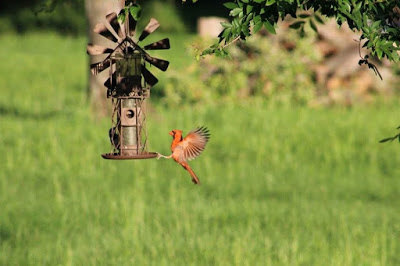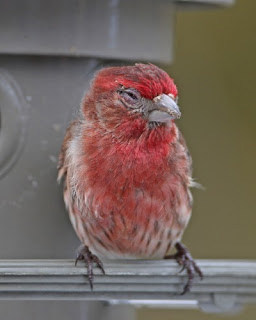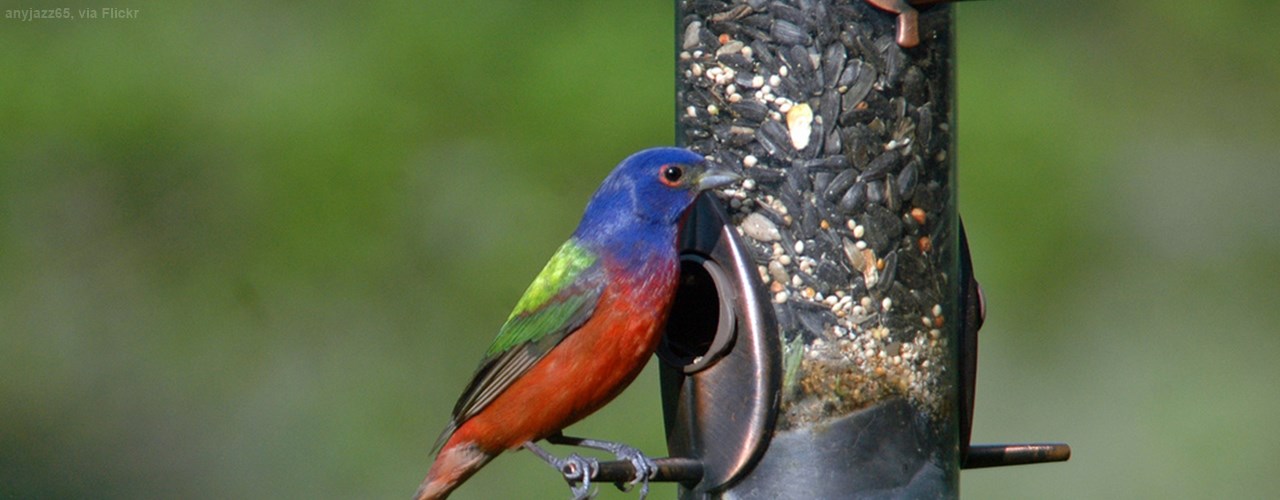Supplemental Feeding for Backyard Wildlife
Providing supplemental feed is a way to quickly attract and maintain frequent visitation of wildlife species in your backyard habitat. When starting a supplemental feeding program make sure to weigh the pros and cons of the practice. For instance, few people give thought about the potential for disease transmission, or attraction of nuisance wildlife. If providing supplemental feed ensure you will be able to provide food year round, especially for bird species. Birds can become especially habituated to feeders and need consistent food sources in order to make it through the winter. If supplemental feeding is stopped it can be detrimental to their survival. Below are a few tips on how to get started, what to feed and methods to manage your backyard in a safe and healthy environment for your outdoor visitors.
Feeder components: Feeding stations for birds should include a watering site, seed, and a container for suet or birdseed cake mixture. The sky is the limit on the various designs and materials for feeders. Many feeders can be purchased or easily built fromcommon household items.

A Northern Cardinal (Cardinalis cardinalis) on a feeder. Photo: Texas A&M AgriLife Extension Service.
Feeder placement: If not placed properly, feeders can become potential bird buffets for predators. Providing feeders in multiple areas in your yard to disperse feeding activity, makes it harder for predators to target one area for their meal. Hanging feeders should be placed far enough off the ground to be out of jumping range. If a feeder is near a tree, trim branches close to the feeder at least 8 feet back so predators cannot use them as a potential ambush location and for post-mounted feeders a metal inverted cone at least 4 feet above the ground and 2 feet in diameter below the feeding platform can serve as a safeguard.
Types of feed: Commercial birdseed mixes usually include a mixture of millet, milo, cracked corn, buckwheat, canary grass seed, sorghum, sunflower seeds, barley, hempseed, oats, safflower, and peanut hearts. These mixtures are excellent, but they can get expensive to provide over time and many people create their own seed mixture by purchasing many of the ingredients in bulk. Before distributing feed, make sure it is clean, dry and free of mold. When birds feed on the ground, they naturally ingest a certain amount of grit that aids in the digestive process. Not all commercial feeds contain grit and could be added to any homemade blends. A teaspoon of fine sand, crushed eggshells, or crushed charcoal added to each quart of feed will ensure birds can efficiently digest the seeds.
Other good sources of supplemental feed for birds include ripe fruits, meal worms, suet and peanut butter with a seed mixture. Chunks of apple, melon, grapes and fresh berries can attract a variety of species, including mockingbirds, robins, thrushes, bluebirds, waxwings, tanagers and catbirds. Orange slices are particularly attractive to orioles during their spring migration. Suet blocks are good for attracting woodpeckers and other insectivorous species and should be placed in a wire cage that hangs on the side of a tree. Suet works best in cooler weather since it will turn rancid in warmer weather.
Hummingbirds require a special diet since they feed almost exclusively on nectar. Commercial solutions containing all needed sugars, vitamins and minerals are available for purchase, but be sure to avoid any mixtures containing dye, food coloring or flavoring. Solutions can be made very easily at home as well by boiling 1 part sugar with 4 parts water; any higher amount of sugar can cause fatal liver hardening in hummingbirds. Never use honey or artificial sweeteners in your homemade solution. Honey can cause botulism and fungus to grow in your feeder and artificial sweeteners have no calories and can cause the birds to starve. Ensure the solution is cool before placing it in the feeder.

A male House Finch (Haemorhous mexicanus) infected with conjunctivitis. Photo submitted by Bob Mayes to the Cornell Lab of Ornithology’s Project FeederWatch.
Cleaning feeders: Ensuring feeders are regularly and properly cleaned is essential to keep birds safe from potential diseases. Feeders can act as reservoirs for many pathogens, including salmonellosis, trichomoniasis, aspergillosis, avian pox and conjunctivitis. Sick birds can display symptoms including but not limited to being less alert, less active, eating less, cowering on the feeder, reluctance to fly and unkempt feathers. Further information and specific symptoms for each disease can be found at the National Wildlife Health Center. In order to discourage mold growth in hummingbird feeders, place them in the shade when hanging and clean with hot water, a small amount of vinegar (no soap or detergent) and a brush every 4-5 days. Clean other bird feeders of old seeds, hulls and droppings at least once or twice a month, but weekly if possible. If you find a dead bird that does not appear to be a victim of predation, immediately disinfect the feeder with a 10% bleach solution and allow it to fully air dry. In order to discourage further disease transmission, wait at least 3-4 weeks before replacing the feeder.
Potential unwanted guests: While feeders are very good at attracting birds, they can also be a magnet for potential pest species including raccoons, mice, chipmunks and squirrels. Store birdseed in metal containers for safe keeping. If you find many insects getting into your feeder, placing petroleum jelly on the openings and the wire used to hang it the feeder in place can helpful to reduce their presence.
When implemented and managed properly supplemental feeding can be a beneficial practice for a variety of species and serve as an essential piece to creating backyard wildlife habitat.
Literature Cited
- Cornell Lab of Ornithology. 2009. About Suet, Mealworms and Other Bird Foods. Web. https://www.allaboutbirds.org/suet-mealworms-and-other-bird-foods/
- National Audubon Society. 2004. Feeder Maintenance & Hygiene. Web. http://web4.audubon.org/bird/at_home/bird_feeding/feeder_maint.html
- National Wildlife Federation. n.d. Bird Feeders. Web. http://www.nwf.org/Garden-For-Wildlife/Food/Supplemental-Feeders.aspx
- National Wildlife Health Center. 2016. Fact Sheet: Coping with Diseases at Bird Feeders. Web. https://www.nwhc.usgs.gov/publications/fact_sheets/coping_with_diseases_at_birdfeeders.jsp
- Texas Parks and Wildlife Department. n.d. Bird Feeders. Web. https://tpwd.texas.gov/publications/nonpwdpubs/introducing_birds/bird_feeders/
--
Edited by Timothy Siegmund, Texas Parks and Wildlife Biologist
--
The Texas A&M Natural Resources Institute grants permission for authors, readers and third parties to reproduce and republish materials from its blogs, publications and online products through permission requests to NRI Communications at nri@tamu.edu. This includes the use of figures, maps, photography and video media. If you have questions about permissions, please contact Brittany Wegner.





